Wetland Diary 29 July 2006
Previous Entry | Wetland Index | Next Entry
I was a warm July afternoon as I set off on the Duck Bus (route 283) to the Wetland Centre. As we crossed the Hammersmith Bridge, I could see that the Thames was very low, and large mud banks were visible.
At this time of year there isn't a great variety of waterfowl at the Centre, but what birds there are tend to be busy with their young. I decided to explore the western side of the reserve, particularly the Wildside area, a group of small ponds and dense reed beds.
Near the amphibian pond I found a Ruddy Darter (Sympetrum sanguineum) making a circuit of the near side of the pond, then returning to rest on a reed. There was also Libellulidae dragonfly, possibly a male Black-tailed Skimmer (Orthetrum cancellatum), but I didn't manage to photograph it clearly. Unlike the Darter it wouldn't let me get close, and kept moving along the path to sun itself. I did manage to photograph a Blue-tailed Damselfly (Ischnura elegans), which were resting on the far side of the pond.

A male Ruddy Darter (Sympetrum sanguineum) perched by the amphibian pond.
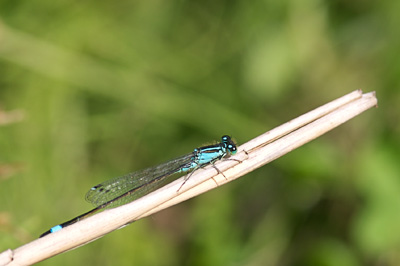
A male Blue-tailed Damselfly (Ischnura elegans) also perched by the amphibian pond.
While I was waiting for a dragonfly to settle, a Grey Heron (Ardea cinerea) flew overhead with a large Eel (Anguilla anguilla) in its beak. I wasn't quick enough with the camera, and it was gone. No frogs, or other amphibians, were seen by the amphibian pond, or anywhere during the afternoon, which was a disappointment.
Coots (Fulica atra) were much in evidence, most with several noisy chicks. Coots are aggressively territorial, and several times I saw one chase away a much larger duck. There were also several Tufted Ducks (Aythya fuligula) with chicks, one group of whom were very close, which gave a good opportunity to capture them diving. The chicks are small dark-brown balls of fluff, and don't look like they would be able to dive, but are prolific divers. The chicks leap forward before diving, which I managed to capture in a photograph (below). When people were near, the mother duck wouldn't dive herself, and kept watch over everything.
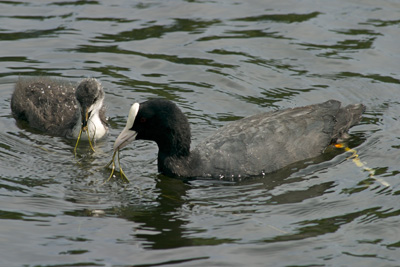
Immature and adult Coot (Fulica atra).
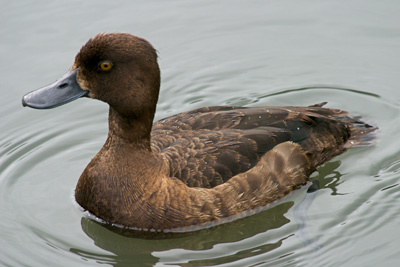
A female Tufted Duck (Aythya fuligula).
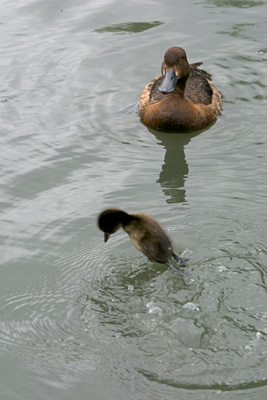
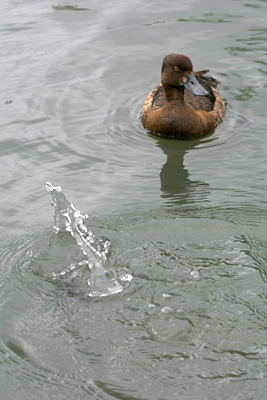
A young Tufted Duck leaps then dives under the watchful eye of its mother.
Nearby was a Mallard (Anas platyrhynchos) nest with young chicks and another group of three Mallard chicks with their mother, one of whom I managed to photograph at quite close range on the path.

Female Mallard (Anas platyrhynchos) on the nest.

Mallard duckling.
In the reeds were many Moorhens (Gallinula chloropus), and also a family of Little Grebes (Tachybaptus ruficollis). The small stripy chicks would remain calm and silent, until an adult surfaced, then they were cheep loudly and swim at full speed towards them.
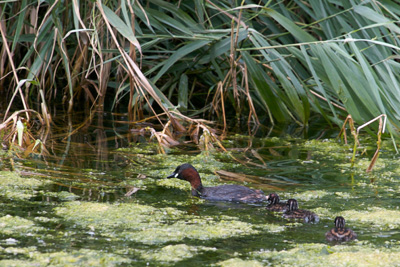
Little Grebe (Tachybaptus ruficollis) with young.
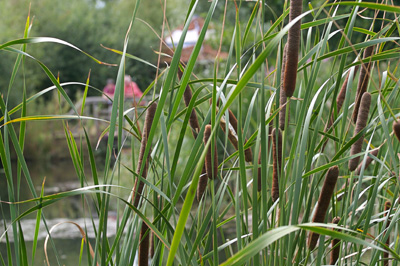
Reedmace (Typha latifolia).
There wasn't much to see from the Headley Hide. The Kingfisher Bank was quiet, and there weren't really anything around other than a few martins hawking for insects.
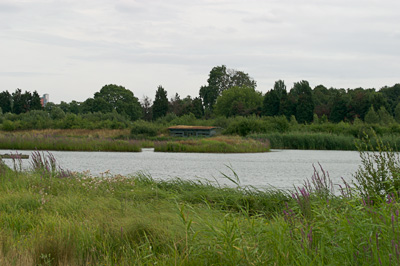
View from the Headley Hide.
Purple Loosestrife (Lythrum salicaria) was everywhere, and the bumble bees were busy visiting the flowers. One Red-tailed Bumblebee (Bombus lapidarius) obligingly landed at the end of of a flower stem, allowing me to capture it clearly.

Red-tailed Bumblebee (Bombus lapidarius) feeds from Purple Loosestrife (Lythrum salicaria).
A pair of Mute Swans (Cygnus olor) were feeding with a cygnet in a channel up towards the Wildside Hide. One swam right up to a walkway, where I caught it just after it had raised its head from feeding, the water still dripping from its beak. The were also a small bird flying between the red beds, but it was never still, and I didn't manage to photograph or identify it.
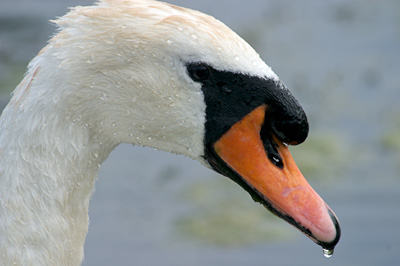
A male Mute Swan (Cygnus olor).
Previous Entry | Wetland Index | Next Entry